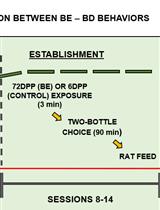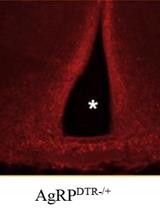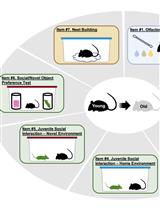- EN - English
- CN - 中文
Protocols to Induce, Prevent, and Treat Post-traumatic Stress Disorder-like Memory in Mice: Optogenetics and Behavioral Approaches
诱导、预防和治疗小鼠创伤后应激障碍样记忆的方案:光遗传学和行为方法
(*contributed equally to this work) 发布: 2021年10月05日第11卷第19期 DOI: 10.21769/BioProtoc.4174 浏览次数: 3581
评审: Arnau Busquets-GarciaNuria DaviuJordi Boix-i-Coll

相关实验方案

从食物到酒精的狂饮:雄性Wistar大鼠嗜酒行为之间的顺序相互作用
Sergio Cuesta-Martínez [...] Cruz Miguel Cendán
2023年08月05日 1292 阅读
Abstract
One of the cardinal features of post-traumatic stress disorder (PTSD) is a paradoxical memory alteration including both emotional hypermnesia for salient trauma-related cues and amnesia for the surrounding traumatic context. Interestingly, some clinical studies have suggested that contextual amnesia would causally contribute to the PTSD-related hypermnesia insofar as decontextualized, traumatic memory is prone to be reactivated in contexts that can be very different from the original traumatic context. However, most current animal models of PTSD-related memory focus exclusively on the emotional hypermnesia, i.e., the persistence of a strong fear memory, and do not distinguish normal (adaptive) from pathological (PTSD-like) fear memory, leaving unexplored the hypothetical critical role of contextual amnesia in PTSD-related memory formation, and thus challenging the development of innovative treatments. Having developed the first animal model that precisely recapitulates the two memory components of PTSD in mice (emotional hypermnesia and contextual amnesia), we recently demonstrated that contextual amnesia, induced by optogenetic inhibition of the hippocampus (dorsal CA1), is a causal cognitive process of PTSD-like hypermnesia formation. Moreover, the hippocampus-dependent contextualization of traumatic memory, by optogenetic activation of dCA1 in traumatic condition, prevents PTSD-like hypermnesia formation. Finally, once PTSD-like memory has been formed, the re-contextualization of traumatic memory by its reactivation in the original traumatic context normalizes this pathological fear memory. Revealing the key role of contextual amnesia in PTSD-like memory, this procedure opens a therapeutic perspective based on trauma contextualization and the underlying hippocampal mechanisms.
Keywords: PTSD (创伤后应激障碍)Background
Post-traumatic stress disorder (PTSD) is a devastating stress-related condition that develops in the aftermath of a traumatic life event experienced as a threat of injury or death. Lifetime prevalence of PTSD is approximately 6-8% in the general population, but 20 to 30% of victims of severe traumatic events (e.g., military combats, terrorist attacks, and rapes) develop this pathology, which can last several years post-trauma (American Psychiatric Association, 2013). Insofar as current treatments are mostly symptomatic, only effective for fewer than half of the patients, and include frequent side effects and residual symptoms, this pathology constitutes a major medical challenge. A cardinal feature of PTSD is a paradoxical memory alteration in which co-exist emotional hypermnesia based on salient/simple trauma-related cues and amnesia for peritraumatic contextual stimuli (Brewin et al., 1996; van Der Kolk, 1994, van Der Kolk et al., 2001; Brewin and Holmes, 2003). In addition, some clinical studies have suggested that contextual amnesia would causally contribute to the PTSD-related hypermnesia: decontextualized, traumatic memory would be out of control, and thus prone to be reactivated by any salient cue more or less related to the trauma and in contexts that may be very different from the original traumatic context (van Der Kolk et al., 2001; Brewin and Holmes, 2003; see also Jacobs and Nadel,1985). However, despite a precise clinical picture of this disorder, the lack of relevant animal models of this “pathological” fear memory has strongly limited our understanding of its underlying neurobiological mechanisms, thereby challenging the development of innovative treatments (for review, see Desmedt et al., 2015). Indeed, most current animal models of PTSD-related memory focus exclusively on emotional hypermnesia, i.e., the persistence of a strong fear memory, which, however, can be perfectly adaptive per se. Thus, not only these models do not take into account the hypothetical critical role of contextual amnesia and its underlying hippocampal dysfunction in PTSD-related memory formation (Elzinga and Bremner, 2002; Bremner et al., 2003), but they do not even distinguish between a normal/adaptive and pathological/maladaptive (PTSD-like) fear memory (for a review entirely dedicated to this issue, see Desmedt et al., 2015).
We developed the first animal model that precisely recapitulates the two memory components of PTSD in mice (i.e., emotional hypermnesia and contextual amnesia) and thus distinguishes “pathological” from “normal” fear memory (Kaouane et al., 2012). Combining contextual fear conditioning, in which a tone is presented but not predictive of a footshock, and post-training corticosterone (CORT) or saline (SAL) injection, we showed that compared to SAL-injected mice that display a normal conditioned fear response restricted to the predictive conditioning context, CORT-injected mice display an abnormally high fear response to the irrelevant tone (pathological emotional hypermnesia) and a reduced fear response to the context (contextual amnesia). Using this model, we recently demonstrated that contextual amnesia, induced by optogenetic inhibition of dorsal CA1, is a causal cognitive process in the formation of PTSD-like hypermnesia, and that hippocampus-dependent contextualization of traumatic memory prevents PTSD-like hypermnesia formation and can restore a normal fear memory once PTSD-like memory has been formed (Al Abed et al., 2020).
Part I: Virus transfection and fiber implantation
Materials and Reagents
Glass capillaries (World Precision Instrument, catalog number: 1B150F-4)
Silicone catheter (Dominique DUTSCHER, Bernolsheim, catalog number: 351070)
Syringe 1 ml (Henke-Sass, Wolf, Tuttlingen, catalog number: 4010.200V0)
Syringe 5 ml (Henke-Sass, Wolf, catalog number: 4050.000V0)
Petri dish 100 × 15 mm (Sigma-Aldrich, catalog number: P5856-500EA)
Implantable Fiber Optic Cannulae (Thorlabs, catalog number: CFMLC12L02)
Optic fiber (Thorlabs, catalog number: FT200EMT)
Patch cable (Thorlabs, catalog number: M83L01)
Ceramic split mating sleeve (Thorlabs, catalog number: ADAL1)
Parafilm (Heathrow Scientific, catalog number: HEA234526A)
Surgical blades (Swann-Morton, Sheffield, catalog number: B.S.2982)
Screws (MicroFastenings, catalog number: M0.6x1.5)
Needle 26 G × ½" (Terumo Medical, catalog number: NN-2613R)
Needle 23 G × 1¼" (Henke-Sass, catalog number: 4710006030)
Cotton swab (The Lab Depot, catalog number: 394305)
Stitching kit and sutures (Péters Surgical, catalog number: 87001F)
6-well culture plate (Corning, Falcon®, catalog number: 353046)
Microscope slide (Thermo Fisher Scientific, catalog number: LCSF02)
Cover slips (Knittel Glass, catalog number: VD12450Y1A.01)
Brush (Henry Schein France, catalog number: 878-7825)
1 L Solvent Bottle (Thermo Fisher Scientific, catalog number: 045900)
Whatman® paper filter (GE Healthcare, catalog number: 1213125)
Young adult (3- to 4-mo-old) C57BL/6 male mice (Charles River, France)
AAV vectors:
AAV-CAMKIIa-hChR2(H134R)-EYFP (University of North Carolina (UNC) Vector Core, see Addgene plasmid # Plasmid #26969 for vector map)
AAV-CAMKIIa-ArchT-GFP (University of North Carolina (UNC) Vector Core, see Addgene plasmid # Plasmid #37807 for vector map)
AAV-CAMKIIa-GFP (University of North Carolina (UNC) Vector Core, see Addgene plasmid # Plasmid #64545 for vector map)
Isoflurane 1,000 mg/g (4% induction and 1-2% for maintenance, Iso-Vet)
Povidone-iodine (Betadine)
Super glue (Loctite)
Liquid fix glue: Methylmethacrylate (Sigma-Aldrich, catalog number: M55909-25 ML)
Super-Bond C&B dental cement (Sun Medical, catalog number: P021E/0A)
Metacam: Méloxicam 1.5 mg/ml analgesic (Boehringer Ingelheim)
Lurocaine: Lidocaïne 20 mg (Vetoquinol, France)
70% ethanol solution (UNIVAR, catalog number: UN1170)
Lacrigel: eye ointment (Europhta, France)
Sulmidol: Sulfapyridine 100 mg (MSD, santé animale, France)
Hydrogen peroxide (Sigma-Aldrich, catalog number: H1009)
Sodium phosphate dibasic, Na2HPO4 (Sigma-Aldrich, catalog number: S0876)
Sodium phosphate monobasic, NaH2PO4 (Sigma-Aldrich, catalog number: S0751)
Sodium chloride, NaCl (Sigma-Aldrich, catalog number: 433209)
Paraformaldehyde (PFA) (Sigma-Aldrich, catalog number: 441244)
Sodium Hydroxide solution 1.0 N, NaOH (Sigma-Aldrich, catalog number: S2770)
FluorSave reagent (Merck, catalog number: 345789)
Sodium Pentobarbital (0.1 ml/10 g mouse body weight, Bioveta)
0.1 M PBS (see Recipes)
0.2 M PB (see Recipes)
PFA 4%/0.1 M PB solution (see Recipes)
Equipment
Small scissors (World Precision Instruments, catalog number: 504615)
Bone scraper (World Precision Instruments, catalog number: 503759)
Drill (RWD Life Science, catalog number: 78001)
Fine tip forceps (World Precision Instruments, catalog number: 501975)
Needle holder with Suture Scissors (World Precision Instruments, catalog number: 500023)
Screwdriver (World Precision Instruments, catalog number: 501635)
Compact Power and Energy Meter Console (Thorlabs, catalog number: PM100D)
Anesthesia system for isoflurane (Datex Ohmeda ISO Isoflurane Anesthesia Vaporizer Tec 7)
Pipette puller (Sutter Instrument, model: P97)
Picospritzer (Parker Hannifin)
Hair clipper (PHYMEP, model: Contura Shaver)
Heating pad (Tem Sega, model: THERM250)
Mouse stereotaxic apparatus (KOPF INSTRUMENTS, model: 942)
Binocular loupe (Leica Microsystems, model: Leica S6E)
Perfusion pump (Cole-Parmer, model: Master Flex® L/S®)
Vibratome (Leica Biosystems, model: Leica VT 1000S)
Microscope (ZEISS, model: Axio Imager A2)
The Mouse Brain in Stereotaxic Coordinates, 2001
TTL pulse generator (Imetronic, Pessac, France)
Procedure
文章信息
版权信息
© 2021 The Authors; exclusive licensee Bio-protocol LLC.
如何引用
Al Abed, A. S., Sellami, A., Ducourneau, E., Bouarab, C., Marighetto, A. and Desmedt, A. (2021). Protocols to Induce, Prevent, and Treat Post-traumatic Stress Disorder-like Memory in Mice: Optogenetics and Behavioral Approaches. Bio-protocol 11(19): e4174. DOI: 10.21769/BioProtoc.4174.
分类
神经科学 > 行为神经科学 > 实验动物模型
系统生物学 > 基因组学
您对这篇实验方法有问题吗?
在此处发布您的问题,我们将邀请本文作者来回答。同时,我们会将您的问题发布到Bio-protocol Exchange,以便寻求社区成员的帮助。
Share
Bluesky
X
Copy link











